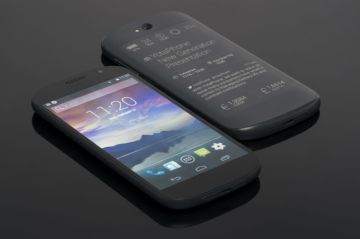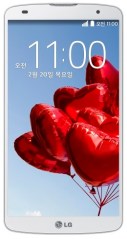Usually, with a big wireless trade show like Mobile World Congress, you can find a common thread that runs between all the most exciting phones and tablets. Not this year. Some vendors are in relentless pursuit of thinner and lighter, while others are leaning on standout software, or new hardware features such as waterproofing or secondary e-ink displays.
Still, the lack of cohesiveness doesn’t make for any less of an interesting trade show, and Mobile World Congress is still the one to watch as major vendors like Samsung, Sony and LG come to hawk their wares.
Here are some of the biggest from this year’s show:
Samsung Galaxy S5

Has Samsung finally reached peak screen size for its flagship phone? The Galaxy S5’s 5.1-inch 1080p display is just a tenth of an inch larger than the S4, making for the smallest size increase in Galaxy S history. Meanwhile, the camera has been bumped up to 16 megapixels, has faster auto-focus and uses more intuitive software. The waterproof chassis has a (potentially finicky) fingerprint reader on the home button and a heart rate monitor on the back that ties into Samsung’s S Health software. Speaking of which, Samsung has somewhat toned down its TouchWiz interface with flatter icons and fewer cheap gimmicks.
It looks like a sensible update for what will likely be the most popular Android phone on the market, and it’s set to launch worldwide on April 11. (U.S. carrier availability may vary.)

Nokia X
As rumored, Nokia has strayed from Windows Phone and built a cheap handset based on Android, albeit a heavily-modified version that swaps Google services for Microsoft ones. Most of the techies who are analyzing the Nokia X to death will probably never buy one, because it’s really intended for people in emerging markets who’ve never owned a smartphone before. But you’ve got to love the drama. Enjoy it while it lasts, because Microsoft could very well kill this little experiment once its acquisition of Nokia goes through.

Huawei MediaPad X1
Yup, it’s another 7-inch Android tablet, but one with super-slim bezels around the screen, taking up just 20 percent of the front surface. The MediaPad X1’s slim aluminum body weighs just 0.53 pounds–much lighter than Apple’s iPad Mini, Amazon’s Kindle Fire HDX and Google’s Nexus 7–and measures 0.28 inches thick. Huawei has also managed to pack in LTE connectivity and voice calling, so you could use the MediaPad X1 as an oversized smartphone. Despite its small size, it still manages a 1920-by-1200 resolution display, quad-core processor, 13-megapixel camera, 5-megapixel front camera and 5,000 mAh battery, supposedly good for 15 hours of web browsing. It’ll be available in March for 399 euros, but there’s no word on U.S. pricing or availability.

Sony Xperia Z2
Sony’s next flagship Android phone isn’t a major departure from the five-month-old Xperia Z1, but it makes improvements in all the right areas. The 5.2-inch, 1080p display is 0.2 inches larger and has wider viewing angles, the quad-core Snapdragon 801 processor is a little faster, there’s 3 GB of RAM instead of 2 GB, and the battery is a little bit bigger at 3,200 mAh. The camera is still 20.7 megapixels, which you can downsample to a smaller image with less noise, but for video it now supports 4K resolution and software-based image stabilization. And with before, the phone is waterproof. The Sony Xperia Z2 will launch in March, with no word on pricing yet.

Sony Xperia Tablet Z2
The “thinnest and lightest” tablet crown is constantly in contention, but Sony’s claim to the world’s “slimmest and lightest waterproof” tablet has a chance to stick for a while. The Xperia Tablet Z2 weighs 0.97 pounds and measures a quarter-inch thick, while packing a 10.1-inch, 1920-by-1200 resolution display. Otherwise it’s a fairly typical Android tablet with a few Sony extras thrown in, such as its Walkman music player and Playstation Mobile games library. The Tablet Z2 will go on sale in Europe and the United Kingdom next month, but no word on a U.S. release date or pricing.

Yotaphone
It’s not the thinnest or lightest phone, and it doesn’t have the fastest processor, the biggest screen or the best camera. What makes Yotaphone different is its rear e-ink display, which lets you keep an eye on notifications while the phone sits on your desk, or use basic functions like the dialer or calculator with less battery drain than the main color screen. Compared to the original Yotaphone, which only launched a few months ago, the second-generation model has a full-touch e-ink screen, better specs and a smoother design. It’ll launch by the end of the year in Europe, the Middle East and Africa, followed by U.S. and Asia launches early next year.

LG G Pro 2
LG’s second attempt to leapfrog Samsung’s Galaxy Note 3 for phablet dominance might have a chance, with big improvements to hardware and software over the original G Pro. The 1080p screen is bigger this time around, measuring 5.9 inches, but LG says it shrunk the bezel for a screen-to-frame ratio of 77.2 percent. The Snapdragon 800 processor is faster, the speakers are louder–addressing a major complaint with the original–and LG is adding both optical and software image stabilization to the 13-megapixel camera.
On the software side, a “Mini View” shrinks the display down when you’ve only got one hand to spare, and you can unlock the phone by tapping the screen in a rhythmic pattern of your choosing. Most amusingly, the camera caters to selfies by adding a bright white background to the screen, creating soft light for your pretty face. It looks more promising, at least, than LG’s curvier endeavors.

Blackphone
A phone that helps you avoid being surveilled might have seemed crazy a year ago, but not anymore. Blackphone is not exactly NSA-proof, but it has a bunch of privacy tools built-in, including encrypted communications from Silent Circle, private search services from Disconnect and encrypted cloud storage from SpiderOak. Other than that, it’s an Android-based phone with decent specs, and while it could still theoretically be hacked by the government through vulnerabilities in Android, at least the idea of someone building a phone around privacy is comforting. The Blackphone ships in June and can be pre-ordered for $629.

HTC Desire 816
While we wait for HTC to reveal its next flagship phone, the company is making good on its promise to target the mid-range market with the Desire 816. If you squint hard enough, you can see a vague resemblance to the HTC One with the inclusion of HTC’s (stupidly-named but otherwise excellent) “BoomSound” front-facing speakers. HTC is also throwing in a 5-megapixel camera in hopes of cashing in on selfie madness, but the other specs are fairly standard, including a 5.5-inch 720p display, Snapdragon 400 processor, 8 GB of storage, 1.5 GB of RAM and a 13-megapixel rear camera. Look for the Desire 816 this spring.

HP Pavilion X360
Let’s throw in a Windows 8 device for good measure. HP’s Pavilion x360 is a shameless copy of Lenovo’s Yoga hybrids, with a swiveling screen that switches between laptop and tablet settings. But at a starting price of just $460, HP is dipping into territory where its top rival won’t tread. Getting to that price requires some sacrifices, however, as the x360 uses a Pentium-series Intel Bay Trail processor with 4 GB of RAM and a hard drive (minimum 500 GB) instead of solid state storage. It’s not a graceful machine either, measuring 0.86 inches thick and measuring 3.08 pounds, but it still makes more sense than a touchscreen laptop that doesn’t let you put the screen front-and-center. The Pavilion x360 is available right now.

